
|
It brightened up to 7.1 mag from May to June (June 21, Juan Jose Gonzalez). Now it is fading. But it is bright as 8.5 mag still now (July 26, Marco Goiato). In the Northern Hemisphere, it will be unobservable in August. In the Southern Hemisphere, it is observable in good condition after this.
Date(TT) R.A. (2000) Decl. Delta r Elong. m1 Best Time(A, h)
July 29 14 23.72 -30 7.8 1.302 1.752 97 8.8 18:43 (111, 79)
Aug. 5 14 30.94 -33 50.2 1.409 1.787 93 9.0 18:47 ( 88, 75)
|
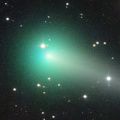
|
Outburst occured on Apr. 4, and it brightened by 2 mag, up to 6.2 mag (Apr. 7, Juan Jose Gonzalez). Now it is fading. But it is bright as 11.2 mag still now (July 25, Chris Wyatt). It stays observable for a long time after this.
Date(TT) R.A. (2000) Decl. Delta r Elong. m1 Best Time(A, h)
July 29 3 23.45 22 29.9 1.661 1.652 71 9.8 5:29 (203, 29)
Aug. 5 3 33.58 22 55.0 1.672 1.733 75 10.0 5:24 (200, 29)
|

|
New bright comet discovered by the All-Sky Automated Survey for Supernovae (ASASSN). Now it is bright as 9.8 mag (July 23, Juan Jose Gonzalez). It is expected to brighten up to 7.5 mag in October. In the Northern Hemisphere, it stays observable in excellent condition for a long time. In the Southern Hemisphere, it is observable in good condition now. But it will be getting lower in September, and it will be unobservable for a long time after October.
Date(TT) R.A. (2000) Decl. Delta r Elong. m1 Best Time(A, h)
July 29 2 48.57 -7 17.5 1.563 1.844 88 10.1 5:29 (207, 60)
Aug. 5 2 59.82 -4 40.4 1.452 1.791 91 9.8 5:24 (200, 58)
|
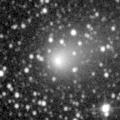
|
Now it is bright as 10.6 mag (July 26, Marco Goiato). It is observable in excellent condition in the Southern Hemisphere. It locates low in the Northern Hemisphere.
Date(TT) R.A. (2000) Decl. Delta r Elong. m1 Best Time(A, h)
July 29 16 52.86 -37 2.9 0.765 1.610 128 10.6 20:25 ( 0, 88)
Aug. 5 17 4.31 -37 26.5 0.814 1.623 124 10.8 20:09 ( 0, 88)
|
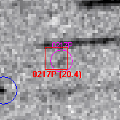
|
Now it is bright as 12.2 mag (July 25, Chris Wyatt). It stays 12 mag until September. In the Southern Hemisphere, it stays at the same altitude in the morning sky. In the Northern Hemisphere, it will be getting higher slowly.
Date(TT) R.A. (2000) Decl. Delta r Elong. m1 Best Time(A, h)
July 29 4 33.57 10 55.7 1.436 1.246 58 11.9 5:29 (227, 31)
Aug. 5 4 58.20 11 27.4 1.443 1.260 58 11.8 5:24 (227, 30)
|
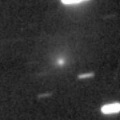
|
Now it is 14.8 mag (July 5, Thomas Lehmann). It will stay bright as 10 mag for a long time from autum to next spring. In the Southern Hemisphere, it stays observable in good condition until next February. In the Northern Hemispehre, it is appearing in the morning sky. Then it stays observable for a long time until the comet will fade out.
Date(TT) R.A. (2000) Decl. Delta r Elong. m1 Best Time(A, h)
July 29 4 58.83 -5 1.2 4.344 3.899 57 13.1 5:29 (245, 38)
Aug. 5 5 4.68 -4 36.2 4.220 3.849 61 13.0 5:24 (241, 41)
|

|
Now it is bright as 13.2 mag (July 25, Chris Wyatt).
Date(TT) R.A. (2000) Decl. Delta r Elong. m1 Best Time(A, h)
July 29 21 29.24 -13 43.5 4.840 5.829 165 13.2 1:04 (180, 69)
Aug. 5 21 26.02 -13 52.6 4.819 5.828 172 13.2 0:33 (180, 69)
|
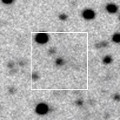
|
Now it is bright as 13.5 mag (July 5, Chris Wyatt). It was expected to brighten up to 12 mag in summer. But actually, it is fainter than expected. It is observable in excellent condition in the Southern Hemisphere. It locates somewhat low in the Northern Hemisphere.
Date(TT) R.A. (2000) Decl. Delta r Elong. m1 Best Time(A, h)
July 29 18 53.43 -29 1.1 1.066 2.033 155 13.6 22:24 (180, 84)
Aug. 5 18 50.15 -28 1.3 1.088 2.022 148 13.5 21:54 (180, 83)
|
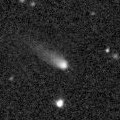
|
Now it is 14.2 mag (July 6, Ken-ichi Kadota). It will brighten up to 13-14 mag and will be observable in good condition in summer.
Date(TT) R.A. (2000) Decl. Delta r Elong. m1 Best Time(A, h)
July 29 22 56.05 12 32.5 1.946 2.739 132 13.7 2:31 (180, 42)
Aug. 5 22 33.43 10 43.9 1.846 2.731 143 13.5 1:41 (180, 44)
|
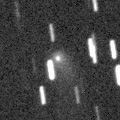
|
Now it is 15.0 mag (July 7, Ken-ichi Kadota). In the Northern Hemisphere, it will brighten up to 14 mag from summer to winter, and it will be observable in excellent condition. It is not observable at all after this in the Southern Hemisphere.
Date(TT) R.A. (2000) Decl. Delta r Elong. m1 Best Time(A, h)
July 29 0 37.43 53 36.3 3.059 3.234 90 14.0 4:11 (180, 1)
Aug. 5 0 31.64 56 36.8 2.989 3.225 94 14.0 3:38 (180, -2)
|

|
Now it is 14.1 mag (June 30, Chris Wyatt). It stays 14 mag from spring to summer. It locates somewhat low in the Northern Hemisphere. The perihelion distance increased from 2.4 a.u. to 2.9 a.u. in this apparition. So it will not be bright as before.
Date(TT) R.A. (2000) Decl. Delta r Elong. m1 Best Time(A, h)
July 29 15 45.22 -23 0.6 2.383 2.938 113 14.3 19:17 (180, 78)
Aug. 5 15 48.17 -23 20.2 2.465 2.933 107 14.4 18:52 (180, 78)
|

|
It has not been observed yet in this apparition. The condition of this apparition is worst. It must have brightened up to 10 mag in spring, but it is not observable at all.
Date(TT) R.A. (2000) Decl. Delta r Elong. m1 Best Time(A, h)
July 29 8 20.19 10 53.5 2.666 1.668 8 14.3 5:29 (264,-11)
Aug. 5 8 37.83 9 38.3 2.724 1.730 9 14.7 5:24 (265, -9)
|
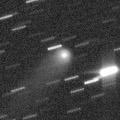
|
Now it is 14.4 mag (July 7, Ken-ichi Kadota). It will be observable at 14 mag for a long time from 2017 to 2018.
Date(TT) R.A. (2000) Decl. Delta r Elong. m1 Best Time(A, h)
July 29 16 45.91 23 35.5 3.682 4.145 110 14.5 20:16 (180, 31)
Aug. 5 16 37.24 23 21.5 3.751 4.119 104 14.5 19:40 (180, 32)
|
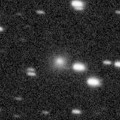
|
Now it is 15.3 mag (July 8, Ken-ichi Kadota). It is expected to brighten up to 9 mag in summer in 2018. In the Northern Hemisphere, it stays observable until 2018 summer while the comet will be brightening. In the Southern Hemisphere, it is hardly observable in 2017, but it will be observable in good condition in 2018.
Date(TT) R.A. (2000) Decl. Delta r Elong. m1 Best Time(A, h)
July 29 17 24.19 48 3.9 4.254 4.558 100 15.2 20:54 (180, 7)
Aug. 5 17 17.79 46 19.8 4.224 4.501 99 15.2 20:21 (180, 9)
|
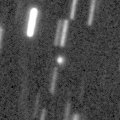
|
Now it is 15.8 mag (July 8, Ken-ichi Kadota). It is expected to brighten up to 11-12 mag from 2018 to 2019. In the Northern Hemisphere, it stays observable in good condition while the comet will be brightening gradually. In the Southern Hemisphere, it is not observable until 2018 October.
Date(TT) R.A. (2000) Decl. Delta r Elong. m1 Best Time(A, h)
July 29 15 23.91 59 4.2 4.478 4.421 80 15.4 18:54 (180, -4)
Aug. 5 15 14.95 58 2.4 4.475 4.370 77 15.4 18:47 (176, -3)
|

|
Now it is 15.6 mag (Mar. 6, Kunihiro Shima). It is appearing in the morning sky. It stays observable at 15.5 mag unil the end of 2017.
Date(TT) R.A. (2000) Decl. Delta r Elong. m1 Best Time(A, h)
July 29 3 25.80 4 36.3 5.924 5.763 76 15.5 5:29 (213, 45)
Aug. 5 3 29.18 4 25.8 5.847 5.789 81 15.5 5:24 (207, 47)
|
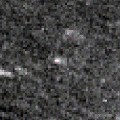
|
Now it is 19.1 mag (June 22, Erwin Schwab, Pablo Ruiz). Return of a new periodic comet which brightened up to 13 mag in 2004. It will be observable in excellent condition in autumn. It is expected to brighten up to 14 mag, if the comet is as bright as when it was discovered.
Date(TT) R.A. (2000) Decl. Delta r Elong. m1 Best Time(A, h)
July 29 1 42.65 -3 57.1 1.336 1.852 103 15.9 5:16 (180, 59)
Aug. 5 1 54.01 -3 3.5 1.259 1.830 106 15.6 5:00 (180, 58)
|
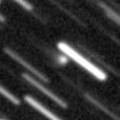
|
Now it is 15.4 mag (July 26, Toshiyuki Takahashi). It stays observable at 16 mag for a long time from 2017 to 2018.
Date(TT) R.A. (2000) Decl. Delta r Elong. m1 Best Time(A, h)
July 29 2 43.28 30 32.1 4.517 4.426 78 15.7 5:29 (191, 23)
Aug. 5 2 41.14 30 8.3 4.374 4.411 85 15.6 5:24 (186, 25)
|
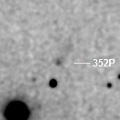
|
First return of a new periodic comet discovered in 2000. Now it is 17.8 mag (June 16, Kunihiro Shima). It will brighten rapidly, and it is expected to be observable at 15.5 mag in good condition from July to September.
Date(TT) R.A. (2000) Decl. Delta r Elong. m1 Best Time(A, h)
July 29 1 13.43 -10 34.3 1.995 2.556 112 15.8 4:47 (180, 65)
Aug. 5 1 16.06 -10 5.0 1.930 2.564 117 15.7 4:22 (180, 65)
|
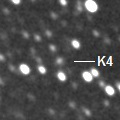
|
Now it is 15.8 mag (June 29, K. Hills). It stays 16 mag for a long time until summer in 2018. In the Southern Hemisphere, it stays observable in excellent condition until autumn. It locates low in the Northern Hemisphere.
Date(TT) R.A. (2000) Decl. Delta r Elong. m1 Best Time(A, h)
July 29 16 43.24 -33 29.2 2.381 3.101 127 15.8 20:15 (180, 88)
Aug. 5 16 44.50 -32 41.2 2.420 3.067 120 15.8 19:49 (180, 88)
|
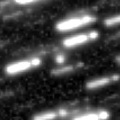
|
Now it is 16.5 mag (July 26, Toshiyuki Takahashi). It was observed at 17 mag in 2016. In 2017, it will be observable at 15.5 mag in good condition from summer to autumn.
Date(TT) R.A. (2000) Decl. Delta r Elong. m1 Best Time(A, h)
July 29 1 35.90 12 32.5 2.489 2.832 99 15.9 5:10 (180, 42)
Aug. 5 1 39.45 13 26.1 2.405 2.837 104 15.8 4:46 (180, 41)
|
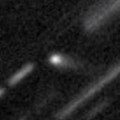
|
Now it is 17.0 mag (May 29, iTelescope Observatory, Siding Spring). It will brighten up to 14.5 mag in winter. In the Southern Hemisphere, it stays observable in excellent condition until spring in 2018. In the Northern Hemisphere, it stays unobservable until 2018.
Date(TT) R.A. (2000) Decl. Delta r Elong. m1 Best Time(A, h)
July 29 1 36.63 -72 50.9 2.185 2.733 112 16.1 5:09 ( 0, 52)
Aug. 5 1 58.94 -74 23.9 2.152 2.681 110 15.9 5:04 ( 0, 51)
|

|
Now it is 19.7 mag (Apr. 27, iTelescope Observatory, Siding Spring). It will pass the perihelion on Oct. 27. In the Southern Hemisphere, it stays observable while the comet will be brightening, until early October when the comet will brighten up to 9 mag. In the Northern Hemisphere, it is not observable at all in this apparition.
Date(TT) R.A. (2000) Decl. Delta r Elong. m1 Best Time(A, h)
July 29 20 55.07 -79 8.5 1.224 1.938 119 16.6 0:35 ( 0, 46)
Aug. 5 18 56.64 -81 48.4 1.177 1.840 114 16.2 21:51 ( 0, 43)
|
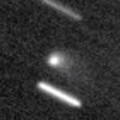
|
Now it is 16.8 mag (July 6, CAO, San Pedro de Atacama). It will brighten up to 15.5 mag in summer. It will be observable in excellent condition in the Southern Hemisphere. It will be getting higher gradually in the morning sky also in the Northern Hemisphere.
Date(TT) R.A. (2000) Decl. Delta r Elong. m1 Best Time(A, h)
July 29 21 48.67 -31 42.3 1.518 2.491 158 16.3 1:23 (180, 87)
Aug. 5 21 41.43 -30 13.9 1.507 2.497 163 16.4 0:49 (180, 85)
|

|
Now it is 16.3 mag (July 7, Ken-ichi Kadota). It stays 16 mag from 2016 to 2017. In the Northern Hemisphere, it stays observable in good condition for a long time. In the Southern Hemisphere, it will never be observable again.
Date(TT) R.A. (2000) Decl. Delta r Elong. m1 Best Time(A, h)
July 29 18 1.55 66 3.1 6.352 6.441 90 16.4 21:31 (180,-11)
Aug. 5 17 56.51 65 52.1 6.368 6.453 90 16.5 20:59 (180,-11)
|
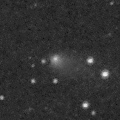
|
Hilda-type minor planet, but the cometary activity was detected on July 3. Now it is bright as 16.5 mag (July 3, G. J. Leonard).
Date(TT) R.A. (2000) Decl. Delta r Elong. m1 Best Time(A, h)
July 29 21 16.21 3 14.0 2.385 3.336 155 16.6 0:51 (180, 52)
Aug. 5 21 11.87 2 43.8 2.381 3.353 160 16.6 0:19 (180, 52)
|

|
Now it is 18.4 mag (May 31, iTelescope Observatory, Siding Spring). It will brighten rapidly, up to 15 mag in autumn, and will be observable in good condition in the Northern Hemisphere. It locates low in the Southern Hemisphere.
Date(TT) R.A. (2000) Decl. Delta r Elong. m1 Best Time(A, h)
July 29 3 19.39 17 16.4 1.947 1.929 73 16.8 5:29 (204, 34)
Aug. 5 3 33.93 18 46.6 1.878 1.920 76 16.7 5:24 (202, 33)
|

|
It brightened up to 11 mag from spring to summer in 2016. Now it is 17.4 mag (July 14, Ken-ichi Kadota). It stays observable for a long time after this, but it will be fainter than 18 mag in October.
Date(TT) R.A. (2000) Decl. Delta r Elong. m1 Best Time(A, h)
July 29 19 51.33 -19 35.9 2.390 3.395 170 16.7 23:22 (180, 75)
Aug. 5 19 45.72 -19 56.0 2.450 3.430 162 16.8 22:49 (180, 75)
|
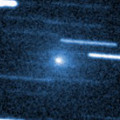
|
It brightened up to 11 mag from March to April. Now it is fading. It has faded down to 12.7 mag in late May (May 26, iTelescope Observatory, Siding Spring). No observations have been reported after that. It will be getting higher gradually in the morning sky.
Date(TT) R.A. (2000) Decl. Delta r Elong. m1 Best Time(A, h)
July 29 3 57.95 7 42.1 2.168 2.010 67 16.7 5:29 (220, 38)
Aug. 5 4 5.80 7 22.4 2.175 2.099 72 17.0 5:24 (216, 41)
|

|
Now it is 17.6 mag (June 30, ATLAS-MLO, Mauna Loa). It brightens up to 16.5-17 mag in August, and it will be observable in good condition.
Date(TT) R.A. (2000) Decl. Delta r Elong. m1 Best Time(A, h)
July 29 16 3.30 -10 32.7 0.370 1.217 114 16.9 19:36 (180, 65)
Aug. 5 16 26.61 -4 53.7 0.386 1.213 112 16.8 19:32 (180, 60)
|
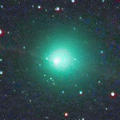
|
It brightened up to 7.2 mag in spring (Mar. 24, Marco Goiato). Now it is 16.9 mag (June 2, T. Ikemura, H. Sato). It will be fainter than 18 mag in late August. It is observable in good condition in the Southern Hemisphere. It locates low in the Northern Hemisphere.
Date(TT) R.A. (2000) Decl. Delta r Elong. m1 Best Time(A, h)
July 29 21 15.09 -25 23.1 1.235 2.239 168 16.8 0:50 (180, 80)
Aug. 5 20 59.28 -25 55.2 1.298 2.306 171 16.9 0:07 (180, 81)
|
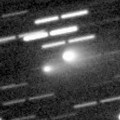
|
It brightened up to 11.5 mag from late March to early April (Mar. 24, Andrew Pearce). Now it is fading. It has already faded down to 17.8 mag (June 30, CAO, San Pedro de Atacama). Bright 12-mag new fragment BT was discovered on Feb. 10, but now it is faint as 18.9 mag (June 2, CAO, San Pedro de Atacama). It will be fainter than 18 mag in September.
Date(TT) R.A. (2000) Decl. Delta r Elong. m1 Best Time(A, h)
July 29 3 0.06 6 31.8 1.822 1.950 81 17.1 5:29 (203, 46)
Aug. 5 3 5.81 6 45.4 1.799 2.013 86 17.2 5:24 (197, 47)
|
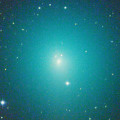
|
It approached to Earth down to 0.14 a.u. from late March to early April, and it brightened up to 6.0 mag (Apr. 7, Juan Jose Gonzalez). Now it is fading. It has already faded down to 12.1 mag (July 17, Thomas Lehmann). It stays observable in good condition after this until the comet fades out.
Date(TT) R.A. (2000) Decl. Delta r Elong. m1 Best Time(A, h)
July 29 18 12.10 -13 17.8 0.766 1.704 145 17.1 21:43 (180, 68)
Aug. 5 18 15.31 -14 57.7 0.860 1.764 140 17.8 21:19 (180, 70)
|
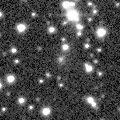
|
It will pass the perihelion in 2019. However, it has not been brightening since the discovery in 2010. It will be getting higher gradually in the morning sky in the Northern Hemisphere. It is not observable for a long time in the Southern Hemisphere.
Date(TT) R.A. (2000) Decl. Delta r Elong. m1 Best Time(A, h)
July 29 5 55.29 63 53.2 9.688 9.103 52 17.2 5:29 (204,-20)
Aug. 5 6 2.73 64 21.6 9.617 9.088 55 17.2 5:24 (202,-19)
|
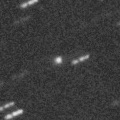
|
Now it is 17.4 mag (July 20, Yuji Ohshima). It is expected to brighten up to 13-14 mag from 2018 to 2019. In the Northern Hemisphere, it stays observable in good condition for a long time. In the Southern Hemisphere, it is not observable until summer in 2018.
Date(TT) R.A. (2000) Decl. Delta r Elong. m1 Best Time(A, h)
July 29 20 14.15 70 30.5 5.700 5.801 90 17.4 23:42 (180,-16)
Aug. 5 19 55.30 70 2.5 5.625 5.754 92 17.4 22:56 (180,-15)
|

|
Now it is 17.9 mag (June 2, MASTER-OAFA Observatory). It will brighten up to 14 mag from autumn to winter in 2018, and it will be observable in excellent condition in the Northern Hemisphere. In 2017, it is observable at 17 mag in excellent condition in the Southern Hemisphere.
Date(TT) R.A. (2000) Decl. Delta r Elong. m1 Best Time(A, h)
July 29 0 26.27 -42 56.8 3.621 4.293 125 17.4 4:00 ( 0, 82)
Aug. 5 0 23.58 -43 39.8 3.532 4.252 129 17.4 3:30 ( 0, 81)
|
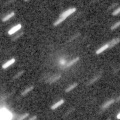
|
Now it is 16.7 mag (June 27, Hidetaka Sato). It will fade out after this, and it will be fainter than 18 mag in August.
Date(TT) R.A. (2000) Decl. Delta r Elong. m1 Best Time(A, h)
July 29 17 45.84 27 25.9 3.311 3.900 118 17.4 21:17 (180, 28)
Aug. 5 17 44.25 27 8.6 3.396 3.936 115 17.6 20:47 (180, 28)
|
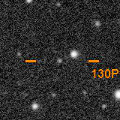
|
Now it is 17.9 mag (May 27, T. Ikemura, H. Sato). It will be brightening slowly until autumn when it becomes 16.5-17 mag. It will be getting lower gradually in the Northern Hemisphere.
Date(TT) R.A. (2000) Decl. Delta r Elong. m1 Best Time(A, h)
July 29 14 25.78 -13 42.0 2.047 2.329 92 17.5 18:43 (151, 66)
Aug. 5 14 32.16 -14 30.0 2.100 2.296 87 17.4 18:47 (138, 64)
|
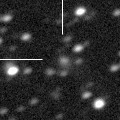
|
Now it is 17.5 mag (June 30, ATLAS-MLO, Mauna Loa). It is already unobservable in the Northern Hemisphere. It will be getting lower gradually after this also in the Southern Hemisphere, and it will be unobservable in September.
Date(TT) R.A. (2000) Decl. Delta r Elong. m1 Best Time(A, h)
July 29 12 55.63 -26 40.8 6.053 5.930 78 17.6 18:43 ( 96, 60)
Aug. 5 12 59.68 -26 3.1 6.161 5.934 72 17.7 18:47 ( 93, 54)
|
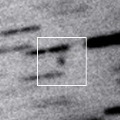
|
Now it is 18.3 mag (June 20, P. Camilleri, H. Williams). It stays observable at 18 mag from spring to summer. It is observable in excellent condition in the Southern Hemisphere. It locates low in the Northern Hemisphere.
Date(TT) R.A. (2000) Decl. Delta r Elong. m1 Best Time(A, h)
July 29 22 20.87 -34 17.3 4.621 5.534 151 17.8 1:55 (180, 89)
Aug. 5 22 17.17 -34 16.8 4.618 5.558 155 17.8 1:24 (180, 89)
|

|
Peculiar asteroid moving along a comet-like orbit. Now it is 18.0 mag (June 26, ATLAS-MLO, Mauna Loa). It is observable at 18 mag in good condition from July to August. It locates somewhat low in the Northern Hemisphere.
Date(TT) R.A. (2000) Decl. Delta r Elong. m1 Best Time(A, h)
July 29 21 21.20 -24 28.3 2.218 3.217 167 17.9 0:56 (180, 79)
Aug. 5 21 9.68 -23 1.6 2.217 3.228 173 17.8 0:17 (180, 78)
|

|
It stayed bright 12 mag for a long time from autum in 2015 to summer in 2016. Now it is fading. It has already faded dwon to 17.9 mag (July 3, ATLAS-HKO, Haleakala).
Date(TT) R.A. (2000) Decl. Delta r Elong. m1 Best Time(A, h)
July 29 15 53.69 -17 4.3 5.047 5.539 114 17.9 19:25 (180, 72)
Aug. 5 15 52.02 -17 37.0 5.208 5.590 107 18.0 18:56 (180, 73)
|
|
![]()
 71P/Clark
71P/Clark 217P/LINEAR
217P/LINEAR C/2016 R2 ( PanSTARRS )
C/2016 R2 ( PanSTARRS ) 29P/Schwassmann-Wachmann 1
29P/Schwassmann-Wachmann 1 213P/Van Ness
213P/Van Ness C/2015 VL62 ( Lemmon-Yeung-PanSTARRS )
C/2015 VL62 ( Lemmon-Yeung-PanSTARRS ) C/2016 N4 ( MASTER )
C/2016 N4 ( MASTER ) 65P/Gunn
65P/Gunn 103P/Hartley 2
103P/Hartley 2 C/2015 O1 ( PanSTARRS )
C/2015 O1 ( PanSTARRS ) C/2016 M1 ( PanSTARRS )
C/2016 M1 ( PanSTARRS ) C/2016 N6 ( PanSTARRS )
C/2016 N6 ( PanSTARRS ) C/2011 KP36 ( Spacewatch )
C/2011 KP36 ( Spacewatch ) P/2017 M2 ( LINEAR-NEAT )
P/2017 M2 ( LINEAR-NEAT ) C/2015 V1 ( PanSTARRS )
C/2015 V1 ( PanSTARRS ) 352P/2017 L1 ( Skiff )
352P/2017 L1 ( Skiff ) C/2017 K4 ( ATLAS )
C/2017 K4 ( ATLAS ) 47P/Ashbrook-Jackson
47P/Ashbrook-Jackson C/2017 K6 ( Jacques )
C/2017 K6 ( Jacques ) 96P/Machholz 1
96P/Machholz 1 C/2017 D2 ( Barros )
C/2017 D2 ( Barros ) C/2014 OE4 ( PanSTARRS )
C/2014 OE4 ( PanSTARRS ) (457175) 2008 GO98
(457175) 2008 GO98 145P/Shoemaker-Levy 5
145P/Shoemaker-Levy 5 81P/Wild 2
81P/Wild 2 C/2017 E1 ( Borisov )
C/2017 E1 ( Borisov ) 189P/NEAT
189P/NEAT 2P/Encke
2P/Encke 73P/Schwassmann-Wachmann 3
73P/Schwassmann-Wachmann 3 41P/Tuttle-Giacobini-Kresak
41P/Tuttle-Giacobini-Kresak C/2010 U3 ( Boattini )
C/2010 U3 ( Boattini ) C/2017 M4 ( ATLAS )
C/2017 M4 ( ATLAS ) (944) Hidalgo
(944) Hidalgo C/2016 B1 ( NEOWISE )
C/2016 B1 ( NEOWISE ) 130P/McNaught-Hughes
130P/McNaught-Hughes C/2017 E3 ( PanSTARRS )
C/2017 E3 ( PanSTARRS ) C/2015 H2 ( PanSTARRS )
C/2015 H2 ( PanSTARRS ) 2017 MZ4
2017 MZ4 C/2014 W2 ( PanSTARRS )
C/2014 W2 ( PanSTARRS )![]()


































